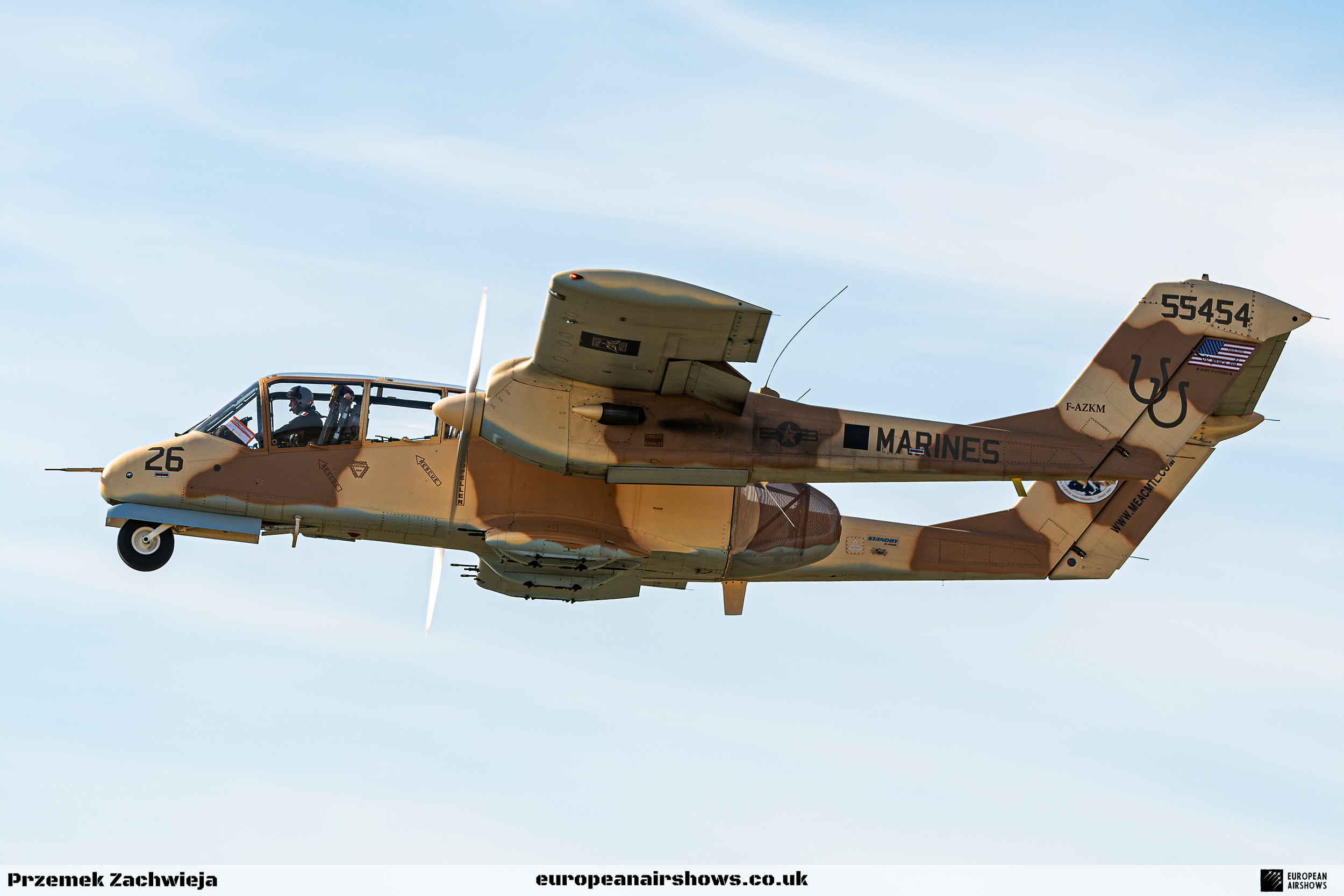
July 16 / OV-10 Bronco first flight
First Flight 16 July 1965
North American Rockwell OV-10 Bronco
The North American Rockwell OV-10 Bronco is an American twin-turboprop light attack and observation aircraft. It was developed in the 1960s as a special aircraft for counter-insurgency (COIN) combat, and one of its primary missions was as a forward air control (FAC) aircraft. It can carry up to 3,200 lb (1,450 kg) of external munitions and internal loads such as paratroopers or stretchers, and can loiter for three or more hours.
The North American Rockwell OV-10 Bronco is an American twin-turboprop light attack and observation aircraft. It was developed in the 1960s as a special aircraft for counter-insurgency (COIN) combat, and one of its primary missions was as a forward air control (FAC) aircraft. It can carry up to 3,200 lb (1,450 kg) of external munitions and internal loads such as paratroopers or stretchers, and can loiter for three or more hours.
The aircraft was initially conceived in the early 1960s through an informal collaboration between W.H. Beckett and Colonel K.P. Rice, U.S. Marine Corps, who met at Naval Air Weapons Station China Lake, California, and who also happened to live near each other. The original concept was for a rugged, simple, close air support aircraft integrated with forward ground operations. At the time, the U.S. Army was still experimenting with armed helicopters, and the U.S. Air Force was not interested in close air support.
The concept aircraft was to operate from expedient forward air bases using roads as runways. Speed was to be from very slow to medium subsonic, with much longer loiter times than a pure jet. Efficient turboprop engines would give better performance than piston engines. Weapons were to be mounted on the centerline to get efficient unranged aiming. The inventors favored strafing weapons such as self-loading recoilless rifles, which could deliver aimed explosive shells with less recoil than cannons, and a lower per-round weight than rockets. The airframe was to be designed to avoid the back blast.
A "tri-service" specification for the light-armed reconnaissance aircraft (LARA) was approved by the U.S. Navy, Air Force, and Army, and was issued in late 1963. The LARA requirement was based on a perceived need for a new type of "jungle fighting" versatile light attack and observation aircraft. Existing military aircraft in the observation role, such as the Cessna O-1 Bird Dog and Cessna O-2 Skymaster, were perceived as obsolescent, with too slow a speed and too small a load capacity for this flexible role.
The specification called for a twin-engined, two-man aircraft that could carry at least 2,400 pounds (1,100 kg) of cargo or six paratroopers or stretchers, and be stressed for +8 and −3 g (basic aerobatic ability). It also had to be able to operate from an aircraft carrier, fly at least 350 miles per hour (560 km/h), take off in 800 feet (240 m), and convert to an amphibious version. Various armaments had to be carried, including four 7.62 mm (0.300 in) machine guns with 2,000 rounds, and external weapons including a gun pod with 20 mm (0.79 in) M197 electric cannon, and AIM-9 Sidewinder air-to-air missiles.
Eleven proposals were submitted, including the Grumman Model 134R tandem-seat version of the already-fielded U.S. Army's OV-1 Mohawk (the U.S. Marine Corps dropped out of the Mohawk program in 1958), Goodyear GA 39, Beechcraft PD-183, Douglas D-855, Convair Model 48 Charger, Helio 1320, Lockheed CL-760, a Martin design, and the North American Aviation/Rockwell NA-300.
In August 1964, the NA-300 was selected. A contract for seven prototype aircraft was issued in October 1964. Convair protested the decision and built a small-wing prototype of the Model 48 Charger anyway, which first flew on 29 November 1964. This was also a twin-boom aircraft that had a broadly similar layout to the OV-10. The Charger, while capable of outperforming the OV-10 in some respects, crashed on 19 October 1965 after 196 test flights. Convair subsequently dropped out of contention.
The Bronco started flying midway through the Charger's test program on 16 July 1965 and became one of the premier COIN aircraft of the next 30 years. It did not achieve Rice's L2 VMA concept, because the DoD insisted on 40-ft-long wings, which made it depend on airbases.
The Bronco performed observation, forward air control, helicopter escort, armed reconnaissance, utility light air transport, and limited ground attack. The Bronco has also performed aerial radiological reconnaissance, tactical air observation, artillery and naval gunfire spotting, airborne control of tactical air support operations, and front-line, low-level aerial photography. A prototype in Vietnam designed to lay smoke was extremely successful, kept in service by evaluators for several months, and only reluctantly released, but was not purchased due to a perceived lack of mission.
Bronco Facts
Purpose-Built for COIN: The OV-10 Bronco was specifically designed for Counter-Insurgency (COIN) operations. It was intended to provide close air support, reconnaissance, and forward air control in low-intensity conflict environments.
First Flight: The OV-10 made its maiden flight on July 16, 1965. Its design was the result of a collaboration between North American Aviation (later part of Rockwell International) and the U.S. Marine Corps, who needed a rugged, versatile aircraft for COIN missions.
Twin-Boom Design: One of the most distinctive features of the OV-10 Bronco is its twin-boom design. This configuration provides excellent visibility for the crew and allows for a large cargo bay in the fuselage, capable of carrying troops, cargo, or even stretchers for medical evacuation.
STOL Capabilities: The Bronco is capable of Short Takeoff and Landing (STOL) operations. It can operate from short, unprepared airstrips, making it highly versatile and suitable for forward operating bases in remote or austere environments.
Versatile Armament: The OV-10 Bronco can be armed with a wide variety of weapons, including machine guns, rockets, bombs, and missiles. It has four underwing hardpoints and one centerline hardpoint, allowing it to carry a diverse payload for different mission requirements.
Multi-Role Aircraft: In addition to its COIN role, the OV-10 has been used for various other missions, including forward air control, reconnaissance, target marking, and even light transport. Its versatility has made it a valuable asset in numerous operational theaters.
Combat Proven: The OV-10 Bronco saw extensive combat use during the Vietnam War. It was used by the U.S. Marine Corps, U.S. Air Force, and U.S. Navy for close air support, reconnaissance, and forward air control missions. Its ruggedness and reliability earned it a strong reputation among its operators.
International Operators: The OV-10 has been used by several international operators, including the air forces of Thailand, Colombia, Indonesia, and the Philippines. These countries have employed the Bronco for COIN, border patrol, and anti-narcotics missions.
Civilian Use: After their military service, some OV-10 Broncos have been converted for civilian use. They have been employed in roles such as aerial firefighting, where their STOL capabilities and rugged design make them well-suited for operating in challenging environments.
Modern Upgrades: Despite its age, the OV-10 Bronco has been subject to various modernization programs. Upgraded avionics, improved engines, and enhanced weapon systems have been integrated into some models, extending their operational life and improving their capabilities.















